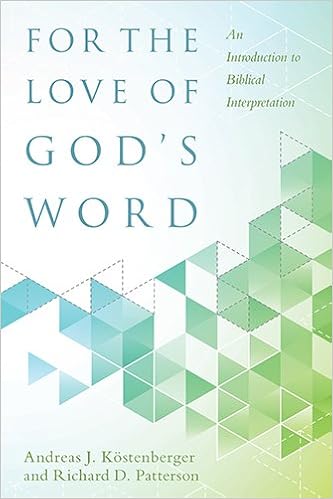Andreas J. Kostenberger, Richard D. Patterson, FOR THE LOVE OF GOD’S WORD: AN
INTRODUCTION TO BIBLICAL INTERPRETATION, Grand Rapids , Kregel Academic, 2015.

This book is impressive. It is an abridgment and revision to
their work published in 2011: INVITATION TO BIBLICAL INTERPRETATION; EXPLORING
THE HERMENEUTICAL TRIAD OF HISTORY, LITERATURE, AND THEOLOGY. It retains the
essential core of the larger work. This work is written as a textbook as
evident by the design of the book. Each chapter begins with the objectives,
outline, and ends with guidelines, key words, assignments, and key resources. At
the end of the book one will find a glossary defining the key words of the
text, which is helpful for student and reader alike. There are also a number of
charts throughout the book that will be an aid to the student. One thing that
disappoints me is that the key resources seem too brief, limited to two per
chapter.
In their introductory chapter, the authors convey the
importance of Biblical interpretation and that it should follow the triad
model: history, literature, and theology. I like the observations that are
needed for the interpreter to be humble, study perceptively, being regenerate, Spirit-filled
and led. Those points cannot be over emphasized nor overlooked. The heart of
their model is the realization that each biblical passage has a historical
setting, a literary dimension, and theological message. The role of the
interpreter is to be a participant with the text, not merely a recipient. It is
evident they have a high view of Scripture and its importance.
The book divides itself into three parts of the triad: Part
1 is History (Chapter 2); Part 2 is Literature (Chapters 3-13). This is the
heart of the book which is found in three units: Canon, Genre, and Language.
Ending the book is Part 3, Theology.
Part 1: History (Chapter 2)
The Bible text has a historical setting, and the interpreter
needs to understand the text was not written in a vacuum. They point out that
this is part of the context of the text. This includes another triad (my term)
of chronology, culture, and archeology. One key they present is for the
interpreter to look for links to the historical information in the text. They
are continually referring to the historical context throughout each part of
their triad.
Part 2: Scripture (Chapters 3-13)
Clearly the heart of their interpretative triad, which is
presented by another triad: Canon, Genre, and Language. Under canon they deal
with the major parts of biblical revelation both in the Old and New Testament.
In the Old Testament it is Law, the Prophets, and the Writings. The authors
give an overall good presentation of these areas of the Old Testament, giving sound
guidelines for applying each. They center each area in the Old Testament on the
key concepts of Covenant and Messiahship. On the New Testament Canon they hold
that its overall purpose is that of fulfillment of the Old Testament hope and
message in Christ (p. 86). The New Testament canon is made up of the Gospels,
Acts, Epistles, and Revelation.
They give good and balanced characteristics of each of the
main genres of Scripture. They equate the genre as the guiding rules of
interpretation, and that each genre has different modes and styles of use. They
handle controversy within the genre in an understandable way, coming up with a
reasonable solution (although one may not agree with their solution). I
especially appreciated their chapter on the Parables. It was clear, concise,
and informative about the genre. Parables are an authentic teaching of Jesus.
They point out the characteristics of the genre that make them earthy,
understandable, and identifiable with the common person. The chapter I had
trouble with is the one on Apocalyptic Literature, and may be caused by my
personal aversion to the term. They identify the essential elements of the
genre as visionary, symbolic, and dualistic. There is a strong emphasis on the
symbolic aspect of the book of Revelation. There is strong emphasis on the
integrity and authority of Scripture.
In the third part triad on Scripture is language. They begin
by pointing out that language is fluid; that it is subject to change and
modification in time. The emphasis in language is on context. They point out
that “hermeneutical purpose is the determination of authorially intended
meaning” (page 331). Everyone should read the 10 word study fallacies that are
discussed in chapter 13. We need to be aware of them for they are common and at
times may be subject to using them.
Part 3: Theology (Chapters 14-15)
They proclaim that this is the mountain top of hermeneutical
study. The focus here is Biblical Theology, not systematic theology. They give
two methods of Biblical Theology as historical, and it seeks to study Scripture
on its own terms. They look at how Scripture uses scriptures, especially in the
use of Old Testament in the New Testament.
Chapter 15 seems to be a disconnect. It deals not with
theology, but with application. It opens with resources that the should be used
for Bible study; both print and electronic. The rest of the chapter deals with
application, giving good and appropriate steps in application. He closes with
the virtues that are to be cultivated by the interpreter.
Overall, this is a good work on hermeneutics, but there are
better ones, however it should not be overlooked. One will find value and
helpful elements on the study of the Word. It is worth having on the shelf of
your library.
No comments:
Post a Comment